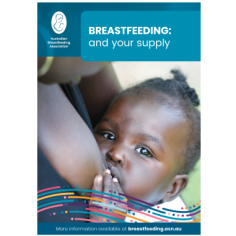What does a constantly crying baby, too much milk, windiness and green poo have in common?

Lactose overload is often seen in young babies when their mums make too much milk. They take large amounts of breastmilk and may be ‘windy’, crying or hard to settle after feeds.
Your baby may have more wet nappies and poos than normal in 24 hours. The poos may be green and frothy or explosive.
What is lactose?
Lactose is the milk sugar present in your milk. The level in breastmilk stays almost the same and is a major part of the milk. Your breasts make lactose as part of making milk. It doesn't come from your diet.
Lactose is a normal part of your baby's diet and breaks down as the milk passes through their gut. As they feed, the fat content in the breastmilk increases. Fat slows down the movement of the milk through your baby’s gut, giving more time for the lactose to be broken down.
In the past, 'foremilk' and 'hindmilk' used to describe breastmilk with lower or higher fat content. We now know that the change is very gradual.
What is lactose overload?
If your baby is drinking large amounts of milk, the gut can’t deal with so much lactose at once, and a lot of it isn't digested. When this extra lactose reaches baby's lower bowel, normal gut bacteria use it and release gas that causes wind and pain. Your baby may have many large, runny bowel motions. They may also have nappy rash as the poo is more acid.
Why does this happen?
If you have a lot of milk and you swap your baby to the second breast after only a few minutes on the first side, they will take a large amount of lower-fat milk from both breasts. With less fat, the milk moves through their body too fast for all the lactose to be broken down and absorbed.
Because they have tummy pain, they may want to suck often for comfort. This may look like they are hungry again. If you keep giving feeds, this can make the whole situation worse.
Does my baby have lactose overload?
You may find that:
-
Your baby is very unsettled.
-
They have adequate to large weight gains.
-
They usually pass urine more than 10 times a day.
-
They have many bowel motions in 24 hours. The poos may be green and frothy or explosive, similar to those of a baby with lactose intolerance.
-
Ironically, you may think that you have a low milk supply because your baby always seems to be hungry.
Green poo on its own can be normal. Baby poo can be anything from orange to yellow to green. If it is dark green but in small amounts, it can be a sign of too little milk.
What can help?
If your baby is suffering from lactose overload, it will be helpful to work out why this might be happening.
First you may need to reduce your oversupply
It is important to take simple steps to reduce your oversupply. If after doing these for several weeks, you see no change to your baby’s behaviour or nappies, you may think about feeding your baby on the same breast for two or more feeds in a row. This is called block feeding.
Block feeding
The aim of block feeding is to slow the rate at which milk goes through the baby by feeding one breast per feed. This is usually only necessary for a few days.
Only use this method if you are certain that you have too much milk, by checking how many wet and dirty nappies your baby is having. They must also be gaining weight well. It is best to carry out this method with help from an ABA counsellor or a lactation consultant.
To block feed, set a 4-hour time period (more or less, depending on how bad your oversupply is) and every time your baby wants to feed during this period, use the same breast. Then use the other breast for the next 4 hours, etc. Each time your baby returns to the already used breast, they get a lower-volume, higher-fat feed that helps slow their system down.
The aim of block feeding is to leave each breast full for longer. This reduces the speed that the breast makes milk. It also lets your baby have some feeds from a softer breast. In this way, they get milk at some feeds that is creamier than if your breast was full.
While block feeding, see that your unused breast doesn’t get overfull. Check your breasts carefully for signs of breast inflammation and begin treatment straight away.
In most cases you should see a difference in 1 to 3 days. As soon as your baby's symptoms are relieved, go back to normal breastfeeding.
Block feeding is designed to reduce your milk supply. Be careful not to keep block feeding longer than you need to.
You may like to get help from an ABA counsellor, an International Board Certified Lactation Consultant (IBCLC) or other health professional with an interest in infant feeding.
By Joy Anderson BSc(Nutrition), PostgradDipDiet, IBCLC, ABA Breastfeeding Counsellor
© Australian Breastfeeding Association April 2022
Read more about oversupply
Online interactive session free for members
Newborn Virtual Village: working out your supply

Evidence-led info and practical tips from our Breastfeeding Information Series
Breastfeeding: and your supply




